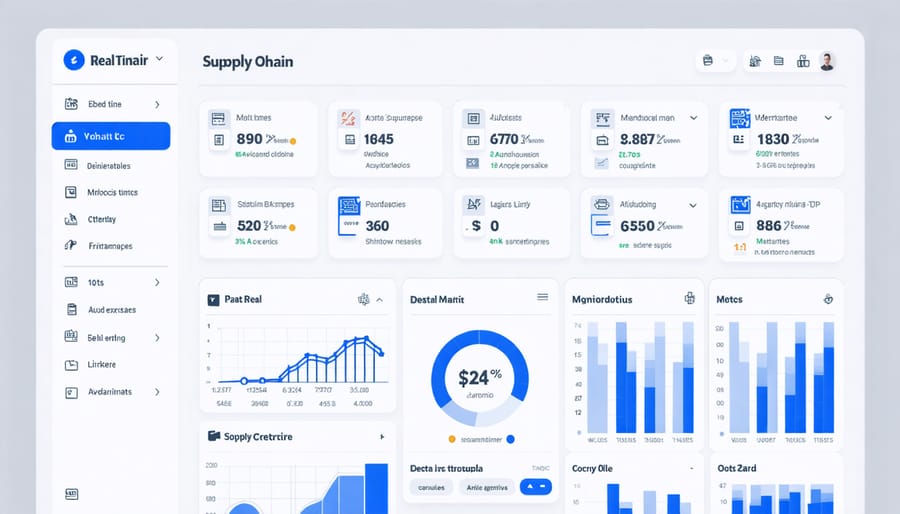In today’s volatile global marketplace, effective supply chain risk management isn’t just a competitive advantage—it’s a fundamental necessity for business survival. Strategic supply chain disruption planning directly impacts 85% of companies’ bottom lines, yet only 41% have comprehensive risk management protocols in place. Modern supply chains face unprecedented challenges, from geopolitical tensions and climate events to cybersecurity threats and pandemic-related disruptions, making robust risk management strategies essential for protecting your solar investment and maintaining operational resilience.
Forward-thinking organizations must implement multi-layered defense strategies that combine real-time monitoring, predictive analytics, and adaptive response mechanisms. This approach enables businesses to not only identify and mitigate potential risks but also transform challenges into opportunities for enhanced operational efficiency and market leadership. By embracing comprehensive supply chain risk management, companies can secure their competitive position while ensuring long-term sustainability and growth in an increasingly complex global business environment.

Key Vulnerabilities in Solar Supply Chains
Raw Material Dependencies
Raw material dependencies present significant challenges in supply chain risk management, particularly in industries reliant on critical minerals and rare earth elements. The geographic concentration of these materials often creates vulnerabilities, with over 80% of rare earth processing occurring in a single region. Companies must carefully assess their exposure to material shortages and price volatility through comprehensive supply chain mapping.
Strategic approaches to managing raw material risks include diversifying supplier networks across multiple regions, developing alternative material specifications, and maintaining strategic stockpiles of critical components. Organizations are increasingly implementing early warning systems to monitor geopolitical tensions, trade policy changes, and market dynamics that could impact material availability.
Advanced analytics and market intelligence tools help organizations forecast potential disruptions and adjust procurement strategies accordingly. Leading companies are also investing in recycling programs and circular economy initiatives to reduce dependence on primary raw materials. Building strong relationships with key suppliers and establishing long-term contracts with price stabilization mechanisms can provide additional protection against supply chain vulnerabilities in critical raw materials.
Manufacturing and Quality Control Challenges
Manufacturing quality control presents significant challenges in solar energy supply chains, particularly when dealing with complex components and international sourcing. Companies must navigate stringent quality standards while managing production timelines and cost considerations. Quality assurance protocols are essential for identifying and addressing critical solar safety risks throughout the manufacturing process.
Key challenges include maintaining consistent product quality across multiple suppliers, ensuring compliance with international standards, and implementing effective quality control measures at various production stages. Organizations must establish robust testing procedures, conduct regular audits, and maintain detailed documentation of quality control processes.
To mitigate these challenges, companies should implement comprehensive quality management systems, invest in advanced testing equipment, and develop strong relationships with reliable suppliers. Regular training programs for quality control personnel and clear communication channels between manufacturing facilities and quality assurance teams are essential for maintaining high standards.
Documentation and traceability systems help track components from source to installation, enabling quick identification and resolution of quality issues while minimizing potential risks to project timelines and budgets.
Proactive Risk Mitigation Strategies
Supplier Diversification
Developing a diversified supplier network is one of the most effective risk mitigation strategies in modern supply chain management. Organizations should maintain relationships with multiple suppliers across different geographical regions to reduce dependency on single sources and minimize disruption risks.
A robust supplier diversification strategy typically involves tiered sourcing arrangements, where primary suppliers are backed by secondary and tertiary alternatives. This approach ensures continuity of operations even when primary suppliers face challenges. Organizations should evaluate potential suppliers based on their financial stability, operational capabilities, quality standards, and compliance with regulatory requirements.
Geographic diversification plays a crucial role in building resilience against regional disruptions. By strategically selecting suppliers from different locations, organizations can protect themselves against localized risks such as natural disasters, political instability, or regional economic downturns.
Regular supplier performance monitoring and relationship management are essential components of this strategy. Organizations should implement systematic evaluation processes, maintain open communication channels, and develop collaborative partnerships with key suppliers. This includes sharing forecasts, establishing clear performance metrics, and creating joint contingency plans.
To implement successful supplier diversification, organizations should also consider factors such as transportation logistics, lead times, and total cost of ownership while maintaining consistent quality standards across all suppliers.
Technology and Quality Standards
Technology plays a pivotal role in modern supply chain risk management, enabling organizations to implement robust quality control measures and maintain visibility across their operations. Advanced tracking systems, such as RFID technology and IoT sensors, provide real-time monitoring of inventory movements and environmental conditions, helping companies identify potential risks before they escalate into major disruptions.
Quality management systems (QMS) should be integrated with supply chain operations to ensure consistent product standards and supplier performance. This includes implementing automated quality inspection processes, statistical process control (SPC), and supplier quality management protocols. Organizations should establish clear quality metrics and KPIs, regularly conducting supplier audits and performance assessments.
Blockchain technology has emerged as a powerful tool for supply chain transparency, creating an immutable record of transactions and product movements. This technology enables better traceability, reduces fraud risks, and facilitates faster issue resolution when quality problems arise.
Cloud-based supply chain management platforms provide centralized data management and analytics capabilities, enabling organizations to make data-driven decisions and respond quickly to emerging risks. These platforms should incorporate artificial intelligence and machine learning algorithms to predict potential disruptions and recommend mitigation strategies.
To maintain effectiveness, organizations should regularly update their technology infrastructure and quality control processes, ensuring compliance with international standards such as ISO 9001 and industry-specific regulations. This includes providing adequate training for staff and establishing clear procedures for technology adoption and quality control implementation.

Contract Management and Legal Protection
Effective contract management forms a crucial foundation for supply chain risk mitigation. Organizations should establish comprehensive agreements with suppliers that clearly outline performance expectations, quality standards, and delivery timelines. These contracts should include specific clauses addressing force majeure events, contingency plans, and liability allocation.
Key elements of robust supply chain contracts include detailed service level agreements (SLAs), performance metrics, and penalty clauses for non-compliance. Organizations should implement regular supplier audits and performance reviews as part of their contractual framework. Additionally, warranties and insurance requirements should be clearly specified to protect against potential losses or disruptions.
To enhance legal protection, organizations should consider implementing:
– Multi-sourcing agreements to reduce dependency on single suppliers
– Intellectual property protection clauses
– Data security and confidentiality provisions
– Clear dispute resolution mechanisms
– Exit clauses and transition arrangements
Risk transfer mechanisms, such as insurance policies and performance bonds, provide additional layers of protection. Organizations should regularly review and update their contracts to reflect changing market conditions and emerging risks. Engaging legal experts with industry-specific experience ensures contracts are both comprehensive and enforceable.
Maintaining detailed documentation of all supplier interactions, performance records, and compliance metrics strengthens an organization’s position in potential disputes while facilitating continuous improvement in supplier relationships.
Real-World Implementation
Assessment and Planning
The assessment and planning phase begins with a comprehensive risk assessment of your current supply chain operations. Start by mapping your entire supply chain network, including primary suppliers, secondary suppliers, and logistics partners. Document critical dependencies, potential bottlenecks, and single points of failure that could disrupt operations.
Conduct a detailed vulnerability analysis using both qualitative and quantitative methods. This should include evaluating supplier financial health, geopolitical risks, natural disaster probability, and cybersecurity threats. Prioritize risks based on their likelihood and potential impact on operations, using a risk matrix to visualize and categorize threats.
Develop specific key performance indicators (KPIs) to measure supply chain resilience, such as supplier diversification ratios, inventory turnover rates, and lead time variations. These metrics will help track the effectiveness of your risk management strategies and identify areas requiring immediate attention.
Create detailed contingency plans for high-priority risks, including specific action steps, responsible parties, and recovery timelines. These plans should address various scenarios, from minor disruptions to major catastrophes. Establish clear communication protocols and decision-making hierarchies for crisis situations.
Regular review and updates of your assessment and planning documents are essential. Schedule quarterly reviews to evaluate new risks, assess the effectiveness of existing controls, and update response strategies based on changing business conditions and emerging threats. This ensures your risk management strategy remains relevant and effective over time.
Monitoring and Response Systems
Effective monitoring and response protocols form the cornerstone of a robust supply chain risk management strategy. Modern smart monitoring systems enable real-time tracking of inventory levels, supplier performance, and potential disruptions across the supply network.
Organizations should implement multi-layered monitoring frameworks that include:
– Real-time inventory tracking systems
– Supplier performance dashboards
– Automated alert mechanisms
– Quality control checkpoints
– Delivery status monitoring
When deviations or disruptions are detected, rapid response protocols should be activated immediately. These typically involve:
1. Initial risk assessment and impact analysis
2. Stakeholder notification and communication
3. Alternative supplier activation
4. Resource reallocation
5. Implementation of contingency plans
Regular testing and updating of these systems ensure their effectiveness during actual disruptions. Organizations should conduct quarterly drills and system audits to identify potential gaps and areas for improvement. Documentation of incidents, responses, and outcomes helps refine these protocols over time.
Integration with predictive analytics can enhance monitoring capabilities by identifying patterns and potential risks before they materialize. This proactive approach allows organizations to address vulnerabilities before they impact operations significantly.

Success Metrics and ROI
Measuring the effectiveness of supply chain risk management strategies requires a comprehensive set of key performance indicators (KPIs) and metrics that align with organizational objectives. Successfully implemented risk management strategies typically show improvements in several critical areas:
Lead time reliability has proven to be a fundamental metric, with best-in-class organizations achieving 95% or higher consistency in delivery times. Supplier performance scores, incorporating quality metrics, on-time delivery rates, and compliance adherence, should show at least a 15-20% improvement after strategy implementation.
Financial metrics play a crucial role in determining ROI. Organizations should track risk-adjusted cost savings, which often range from 5-12% of total supply chain costs. Insurance premium reductions, typically 8-15% after implementing robust risk management programs, contribute significantly to ROI calculations.
Quantifiable improvements in inventory optimization (15-25% reduction in safety stock levels) and decreased supply chain disruptions (40-60% reduction in incident frequency) demonstrate strategy effectiveness. Organizations should also monitor supplier diversification metrics, aiming for no single supplier representing more than 20-30% of critical components.
Regular risk assessments should show decreasing vulnerability scores, while resilience metrics like time-to-recovery (TTR) and time-to-survive (TTS) should improve by 30-50%. These improvements directly correlate with enhanced business continuity and stakeholder confidence.
Companies should establish baseline measurements before implementation and conduct quarterly reviews to track progress and adjust strategies accordingly.
Implementing an effective supply chain risk management strategy is crucial for maintaining business continuity and competitive advantage in today’s complex global marketplace. The key to success lies in taking a proactive, systematic approach that combines thorough risk assessment, strategic planning, and continuous monitoring.
Organizations should begin by conducting comprehensive risk assessments, identifying potential vulnerabilities across their entire supply chain network. This includes evaluating suppliers, transportation routes, geopolitical factors, and market conditions that could impact operations. Once risks are identified, businesses must prioritize them based on likelihood and potential impact to allocate resources efficiently.
The implementation of risk mitigation strategies should follow a phased approach, starting with quick wins that deliver immediate value while building toward more complex, long-term solutions. This includes developing strong supplier relationships, diversifying supply sources, maintaining strategic inventory buffers, and investing in technology for enhanced visibility and tracking.
Key action steps for implementation include:
1. Establishing a dedicated risk management team with clear roles and responsibilities
2. Creating detailed contingency plans for various risk scenarios
3. Implementing robust monitoring and early warning systems
4. Developing strong communication protocols with suppliers and stakeholders
5. Regular testing and updating of risk management procedures
6. Investing in training and capacity building for team members
Success in supply chain risk management requires commitment from leadership, adequate resource allocation, and organization-wide buy-in. Regular review and adjustment of strategies ensure they remain relevant and effective as business conditions evolve.
Remember that supply chain risk management is not a one-time project but an ongoing process that requires continuous attention and refinement. Organizations that embrace this approach and maintain flexibility in their strategies will be better positioned to weather disruptions and maintain competitive advantage in an increasingly uncertain business environment.
By following these guidelines and maintaining a proactive stance, organizations can build resilient supply chains that not only protect against risks but also create opportunities for growth and innovation.

